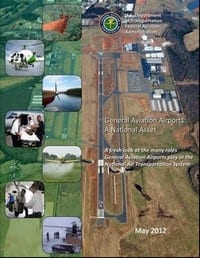WASHINGTON, D.C. — Nearly 50 years ago I wrote a magazine article titled “Airports are for people who DON’T fly.” The FAA’s recently released 18-month study of GA airports has information documenting that claim, which people who don’t fly should know.
The study tells of the many different functions at these airports that advance the public’s interest, including nationwide access to medical flights, search and rescue, disaster relief, aerial firefighting, law enforcement, community access, commercial and industrial activity, and air cargo, as well as the widely recognized business and personal transportation.
 Throughout the United States and its territories, there are more than 19,000 airports, heliports, seaplane bases, and other facilities. Of these, 3,330 are eligible for federal aid. The U.S. has the largest and most diverse network of airports in the world and general aviation is a critical component, according to the FAA study, which will be used in airport planning.
Throughout the United States and its territories, there are more than 19,000 airports, heliports, seaplane bases, and other facilities. Of these, 3,330 are eligible for federal aid. The U.S. has the largest and most diverse network of airports in the world and general aviation is a critical component, according to the FAA study, which will be used in airport planning.
The FAA study, “General Aviation Airports: A National Asset,” notes that only 378 airports across the country support scheduled commercial air service. In addition, there are 121 general aviation airports that support limited scheduled service.
The study divides GA airports into four categories: National, regional, local, and basic. Some provide all aeronautical services, some only a few, but each is a vital location for service to the public.
In 2009, the year studied in the report, general aviation airports contributed $38.8 billion to the economy. Non-airline operators spent more than $12 billion, flying an estimated 27 million flights for emergency medical services, aerial firefighting, law enforcement, border patrol, agricultural functions, flight training, and time-sensitive air cargo services. Besides saving lives and property, use of these airports saves money by providing locations at a lesser cost than would be available at an overcrowded airport busy with airline traffic.
More than 390 GA airports are designated by the federal government to provide critical services for U.S. Customs and Border Patrol, U.S. Marshals Service, the Post Office, Forest Service, and disaster relief. One example cited was how the Joplin Regional Airport played a vital role in recovery efforts after a major tornado tore through the Missouri town in May 2011.
Unknown to most of the public is that their food costs less than if there were no general aviation airports. In 1929 a family spent 23% of its income on food. Today that figure is just 11%. Aerial application of fertilizer, fungicides and pesticides, sprayed by aircraft using general aviation airports, has played an important role in increased productivity. Any other way to dispense these would be far more costly and much slower.
Another money-saving value of GA airports — of which the public generally is unaware — is the savings in energy. Oil and gas companies have an infrastructure of pipelines over large geographic areas. These thousands of miles of pipelines bring gas for utilities and oil for fuel and heating. The fastest and least expensive way to maintain them is to fly the routes in general aviation aircraft with special equipment aboard that document conditions on the ground to identify leaks, ruptures, or other problems. This helps companies save money, which allows them to provide energy products for less.
In many areas of the nation, the general aviation airport provides the fastest, least expensive — and frequently the only — connection with other areas. In Alaska, there are no roads to many areas. Isolated areas in western states get service by air.
Those who think general aviation aircraft are just toys for the wealthy need to look at how GA aircraft are used. About 11% of total general aviation flying is done by people flying themselves on trips related to their businesses. Another 12% of the total hours flown is by corporate aircraft. These professionally flown airplanes are for longer intercontinental or international flights. About one-third of general aviation flight hours are for personal reasons, such as personal or family travel, personal business, personal emergencies, maintaining flight proficiency, or enjoyment.
For more information: FAA.gov
Charles Spence is GAN’s Washington, D.C., correspondent.
People who read this article also read articles on airparks, airshow, airshows, avgas, aviation fuel, aviation news, aircraft owner, avionics, buy a plane, FAA, fly-in, flying, general aviation, learn to fly, pilots, Light-Sport Aircraft, LSA, and Sport Pilot.
